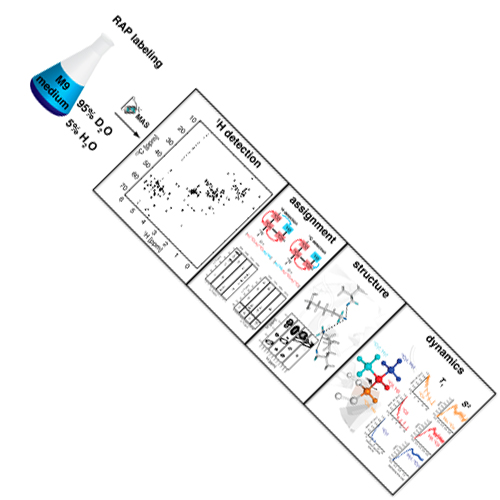Proton-Detected Solid-State NMR Spectroscopy at Aliphatic Sites: Application to Crystalline Systems
07-Jun-2013
Acc. Chem. Res.,, 2013, DOI: 10.1021/ar400063y, 46 (9), pp 2089–2097 published on 07.06.2013
Acc. Chem. Res.,online article
Acc. Chem. Res.,online article
When applied to biomolecules, solid-state NMR suffers from low sensitivity and resolution. The major obstacle to applying proton detection in the solid state is the proton dipolar network, and deuteration can help avoid this problem. In the past, researchers had primarily focused on the investigation of exchangeable protons in these systems. In this Account, we review NMR spectroscopic strategies that allow researchers to observe aliphatic non-exchangeable proton resonances in proteins with high sensitivity and resolution. Our labeling scheme is based on u-[2H,13C]-glucose and 5–25% H2O (95–75% D2O) in the M9 bacterial growth medium, known as RAP (reduced adjoining protonation). We highlight spectroscopic approaches for obtaining resonance assignments, a prerequisite for any study of structure and dynamics of a protein by NMR spectroscopy. Because of the dilution of the proton spin system in the solid state, solution-state NMR 1HCC1H type strategies cannot easily be transferred to these experiments. Instead, we needed to pursue (1H)CC1H, CC1H, 1HCC or (2H)CC1H type experiments. In protonated samples, we obtained distance restraints for structure calculations from samples grown in bacteria in media containing [1,3]-13C-glycerol, [2]-13C-glycerol, or selectively enriched glucose to dilute the 13C spin system. In RAP-labeled samples, we obtained a similar dilution effect by randomly introducing protons into an otherwise deuterated matrix. This isotopic labeling scheme allows us to measure the long-range contacts among aliphatic protons, which can then serve as restraints for the three-dimensional structure calculation of a protein. Due to the high gyromagnetic ratio of protons, longer range contacts are more easily accessible for these nuclei than for carbon nuclei in homologous experiments.Finally, the RAP labeling scheme allows access to dynamic parameters, such as longitudinal relaxation times T1, and order parameters S2 for backbone and side chain carbon resonances. We expect that these measurements will open up new opportunities to obtain a more detailed description of protein backbone and side chain dynamics.











